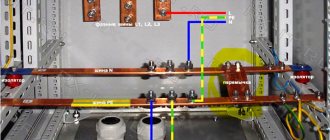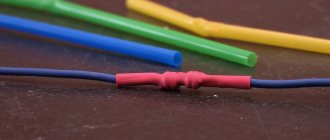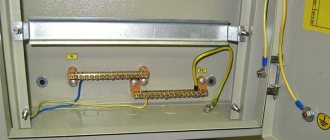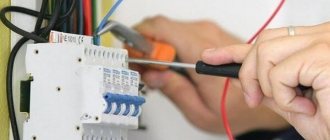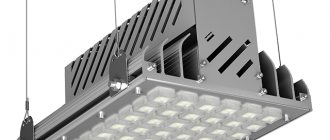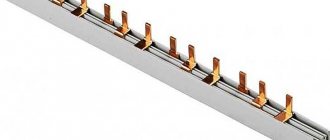Modern requirements for electrical wiring have reached a high standard, as the number of electrical appliances in apartments and houses has increased. Therefore, the wiring must withstand possible loads and meet safety requirements.
During construction or major renovations, a new electrical wiring diagram in the apartment must be developed that will take into account the increased human needs for electricity.
According to new standards, wiring is often thrown along the ceiling
Features of wiring in new houses
The wiring that was done in apartments 40 years ago was designed to operate a small set of appliances - a TV, a refrigerator, lighting. Electric stoves, kettles and boilers gave the maximum loads.
Today, people buy computers, video surveillance systems, powerful home appliances, wireless communication devices and more.
At the same time, the principles of electrical wiring design have not changed, but the network has become more complex and extensive.
Advice! It is important to provide the optimal number of sockets for appliances that will be used by residents. Otherwise, tees and extension cords will be used, which leads to increased loads on individual sections of the wiring and overheating.
The number of electrical outlets has increased
An additional difficulty in drawing up an electrical wiring diagram lies in comparing its operating parameters with the power of the devices.
Therefore, you need to know in advance what will be located where, and what loads it will put on the network.
The second point is the correct lighting of the premises, which is carried out in accordance with the standards of SP 52.13330.2016.
Along with the power network, low-current networks are also used in apartments. These are television and telephone cables, computer equipment, fiber optic networks, intercoms and acoustics. They cannot be physically separated, since the devices are connected to them simultaneously, which means that the position of the routes is taken into account when drawing up the project.
The amount of cable needed to connect all devices has changed significantly. This also applies to lighting.
Previously, rooms were illuminated by one chandelier, but today spot lighting has come into fashion, which allows light to be evenly dispersed over the area of the rooms, as shown in the photo below. Each lamp requires a wire.
Spot lighting
Interesting to know! Modern electrical appliances are not as power-hungry as they used to be. Instead of one incandescent lamp, 10 LED lamps can work at once, giving much more light. This fact allows you to avoid overloading public networks.
We recommend reading: calculation and design of artificial lighting.
How to determine the cross section in practice
The method for calculating the conductor cross-section in practice involves two stages:
- Calculation of the total power of all electricity consumers in the house using the formula: P = (P1+P2…+…Pn)×K×J, where P1+…+Pn is the power of each electrical appliance, K is a coefficient (dimensionless) indicating the percentage of equipment involved (of the total number of cash in the house), J – power reserve factor (usually J = 1.5... 2).
- Determination of the section from the table.
In the above formula, the coefficients are determined through practical research. In particular, K usually does not exceed 0.8 (80%). This means that the equipment in the house is not used at the same time. In fact, you wouldn’t turn on the air conditioner and heating device at the same time.
The power reserve (J) also needs to be taken into account for the future. After all, energy consumption is growing every year. If growth is not taken into account, then after a few years reinforcement of the wiring may be required.
Having calculated the total power of all consumers using the formula, it is easy to determine the required wiring cross-section from the table.
Why do an apartment wiring project?
To ensure safety, the wires are additionally laid in a corrugated PVC hose, which takes up much more space.
Laying 10-15 cables correctly in a row and spreading them around the apartment is an art. And only a professional electrician acting according to the diagram can cope with the task.
Someone will say that the electrician is a perfectionist, but we will answer that the work was carried out according to the project
The second point is the need to decorate and disguise communications. After this, it will be impossible to figure out the location of a large number of conductors without partially damaging the repair.
When the developer keeps the plan, problems of this kind do not arise.
Apartment wiring plan - example
The electrician takes into account the client’s wishes regarding the location of household and heating appliances in the premises, after which he begins drawing up a diagram.
Its task is to divide the cables into groups so that they do not intersect or interfere with each other, and it is also possible to distribute the load in the network evenly.
He thinks over a protection system (some devices require grounding and the presence of separate RCDs) so that the wiring meets safety requirements.
The electrical wiring diagram includes the following elements:
- Distribution panel, which can be intra-apartment or common.
- Electric meter to control electricity consumption.
- Automatic protection devices responsible for stopping the power supply in the event of leaks, human electric shocks, or short circuits.
- Cables and wires with which wiring to electrical points is carried out.
- Switches and sockets for controlling lighting and connecting household appliances.
Voltage drop calculation
Not only the degree of heating of the core, but also the electrical voltage at the far end of the wire depends on the cross-section of the electrical cable. Household appliances are designed for certain parameters of the electrical network, and their constant discrepancy can lead to a reduction in the service life of the equipment.
If the voltage drops on the boiler, it is advisable to install a stabilizer so that the equipment does not experience additional loads due to inconsistencies in the operational characteristics of the electrical network.
As the cable lengthens, a voltage drop occurs. This effect can be reduced by increasing the wire cross-section. It is considered critical to reduce the voltage at the end of the wire by 5% compared to its value at the current source.
This indicator can be calculated using the well-known formula:
Upad = I*2*(ρ*L)/S,
Where:
- ρ – metal resistivity, Ohm*mm2/m;
- L – cable length, m;
- S – conductor cross-section in mm2;
- Upad – drop voltage, Volt;
- I – current flowing through the conductor.
If the calculated voltage drop is more than 5% of the rated voltage, then it is necessary to use a cable with a larger cross-section. This will ensure stable operation of the equipment.
Heating boilers, washing machines and other devices with many relays and sensors are especially sensitive to voltage values. This feature must also be taken into account when using carriers.
The principle of dividing the intra-apartment network - why is it necessary?
An input circuit breaker is installed in the distribution panel of a private house or apartment, to which the power cable is connected. This element controls the intra-house network.
When the switch is turned off, electricity stops flowing to all points. This is convenient when you need to quickly and indiscriminately disconnect the power, but it is extremely inconvenient when you need to turn off the lights only in a certain room.
For this reason, the intra-house network is divided into several groups.
Branching of the intra-house network
Most often, distribution is done by room, but there are other principles of division:
- Separate group for lighting.
- Connecting powerful household appliances.
- Separate kitchen line.
- Separate toilet and bath.
Moreover, the network can branch out at several levels, for example, a separate RCD is placed on an electric oven, which will allow you to leave other household appliances and lighting in the kitchen on if the protection is triggered.
Installation and switching of cables and structures
Electrical wiring in the house is connected to each other using the following method:
- Soldering. Soldering is not used for in-house installation; it is an expensive and labor-intensive process.
- Twisting. The easiest way to install wires from the same material. Copper and aluminum cannot be twisted - the connection will heat up.
- Connections on terminal blocks. Reliable, simple and inexpensive installation method. Terminal blocks of various types, shapes, types and sizes greatly simplify installation.
Line for lighting
The light can be turned off separately or with one common switch.
Multi-level power distribution
Important! If there is one chandelier in the living room, and low-power lamps are used in the rest of the rooms, it makes sense to power them together - this will not create a high load on the network.
If the lighting includes a scattering of devices of different types and purposes, then it is worth breaking it down into groups - a separate main light source, a separate additional spotlight, etc.
Using the same principle, it will be possible to separate the rooms in which the most powerful equipment is installed. This also applies if step-down transformers and various power supplies are installed in the room.
Powerful home appliances
This term refers to those devices that heat something. For example, an electric heating and water heating boiler, an electric stove and an oven. When turned on, they create a high load on the network - 10 Amps is far from the limit.
The heating element from the oven can consume up to 4 kW
The socket and wiring must cope with such a load, as they are designed for loads of 16 Amps.
But, firstly, not all sockets and wires, and, secondly, other devices can work in parallel with them.
Turn on the electric kettle at the same time as the oven, and the protection in the panel will probably trip and the line will be de-energized. For this reason, manufacturers of large household appliances recommend a separate connection.
If such a device breaks down, if it is connected independently, it will be convenient for the master to work. You don't have to look for and reach for the plug, which is usually located in hard-to-reach places.
Kitchen appliances
The reasons here are the same as in the case described above. The kitchen chain is the busiest. There is a high concentration of powerful electrical appliances here.
This includes: washing machines and dishwashers, toasters, microwave ovens, multicookers, bread makers, hoods, grills, meat grinders, water heater, lighting, and so on.
This equipment creates serious loads on the electrical network
Therefore, the kitchen is separated into a separate line, and particularly powerful appliances have their own RCDs, powered from the input circuit breaker.
Such a number of devices requires a thoughtful arrangement of sockets. The group is placed in the work area so that it is possible to connect mobile devices. Sockets for large household appliances are provided separately.
Rooms with high humidity
Previously, there were no sockets in bathrooms and toilets, but today many devices have been invented for this room too.
Using them in a damp environment is dangerous.
For this reason, the room needs other protection devices. The wiring diagram in the bathroom has its own requirements:
- The room junction box should not extend into the room. It can be installed in any convenient adjacent room or corridor.
Junction box on the wall in the hallway
- Each device that will be used in the bathroom must be connected to a separate outlet only. The use of extensions and tees is not permitted.
Separate socket for washing machine
- The switch for controlling the room lighting is installed, like the box, outside the room. The most convenient place is next to the door.
- The electrical cable is laid as close to the ceiling as possible. An insulating corrugation must be used.
Installing electrical wiring in the bathroom
Important! Increased safety requirements are also imposed on fittings. The degree of protection must be at least IP 44. It is recommended to take sockets with a cover that acts as splash protection.
It is recommended to use lamps that operate on 12V voltage. All devices with a metal casing must be grounded.
Interesting to know! This problem remains unsolvable for old houses, in which grounding is not provided in principle.
Many people ground equipment to water pipes, but this should not be done because of the risk of electric shock, not only to you, but also to your neighbors.
In old houses, sometimes a complete reconstruction of electrical networks is carried out, which makes it possible to install an external ground loop. If so, then the residents are lucky - all that remains is to replace the internal wires.
Replacing electrical wiring requires major repairs
Search using the device
One of the best methods for finding out where the wiring is in prefabricated houses is a device for finding hidden cables . There are several variations of the device that work on different principles. The most primitive ones measure the voltage of the magnetic field: current passing through a wire creates lines of force around it, which are recorded by the device. This method has a drawback and it is quite significant: the wire may be de-energized and safely “forgotten” in the wall by the master during a previous redevelopment. Also, such solutions have rather low noise immunity, although modern solutions do not have this drawback. Homemade devices also deserve special attention, but in most cases the apartment owner will not have the time, parts, or necessary skills to create it.
Another option is a small metal detector . It works in reverse. If the first type of device recorded the magnetic field emitted by the wire, then the second one generated it. In practice, this may not provide any particular advantages when searching for cables, although only such a device can find de-energized sections of the network. Another thing is that, in addition to conductors, he is also looking for fittings: when working with a hammer drill, this will be a huge plus. So in the long term, it is recommended to purchase just such a hidden wiring sensor.
The most common solutions of this type are:
- "Woodpecker" . A domestic device that emits a magnetic field and registers its increase in the surrounding space. It has an acceptable search depth - from 7 to 10 centimeters in the wall of a panel house. Allows you to search not only for a line, but also for where it breaks. A cheap and very effective device, the capabilities of which are sufficient for almost every amateur or professional. Negative reviews about the “Woodpecker” are also widespread: if the wire is buried at a large depth, the device may not recognize the conductor or give false signals.
- MS type sensors. Chinese solutions based on the same principle. Unlike the Woodpecker, they have an antenna that amplifies the signal. This does not greatly affect the depth of the search or the quality of work - there are also rarely any complaints about the device. Sometimes the sensitivity of the device is even too high, which can “come out sideways”: sometimes MS even reacts to a nail left in the wall a long time ago. In theory, this is a big plus for working with a hammer drill, but for many it is more of an inconvenience than an advantage.
- Bosch DMF . An advanced device from a higher price category. It has a screen that shows the thickness and depth of the conductor. There is also a sound indication. The device works flawlessly, but is much more expensive. Excellent for detecting wiring in a panel house even under a thick layer of plaster: the stated sensitivity is 10 centimeters, but in practice it is much higher than this figure.
It is also worth mentioning separately about the third type of devices, which are often positioned as solutions for finding hidden wiring in a panel house - thermal imagers . The operating principle of the devices is as follows: they have a screen and a camera that films in the IR (infrared) spectrum. This allows you to locate heating wires and determine how overloaded the line is.
This method has exactly one disadvantage, but it is very significant: with a thick layer of plaster, the heat will dissipate very quickly and the device will simply be useless. Do not forget that its cost is almost an order of magnitude higher than universal devices from Bosch. Thermal imagers are more suitable for shallow wiring or for monitoring cables that are not located inside walls. But in this case, you can use the usual “father’s” method: simply move an indicator screwdriver from a regular outlet along the wall and draw a line along which the wire runs.
Options for electrical wiring diagrams for apartments
Let's consider specific projects of electrical networks for apartments.
This will help you do the work yourself, but consultation with a professional electrician is required.
Studio apartment
These include studio apartments (read the article about the layout of a studio apartment). There are not many rooms in such apartments, so there will not be a lot of wire consumption. There are fewer lines, but it is necessary to ensure the optimal location of each. The general principles remain the same.
It is better to make the living room, kitchen and bathroom into separate groups - this arrangement will be optimal.
The diagram shown shows that the lines are not divided by room. Lighting is assigned to one group, and sockets to the second.
An example of a wiring diagram in a one-room apartment - drawn by hand
Not the best solution and here's why. Distribution boxes are needed for each line entering the rooms. Many outlets are connected in series, which will lead to the shutdown of an entire branch if one single wire burns out.
It's different here. It can be seen that a separate group consists of lighting in the bathroom and sockets installed in it. The remaining rooms are connected separately - the lighting and sockets in them are combined.
What tools will you need?
Tool for installing electrical wiring
Self-replacement of electrical wiring is carried out using the following tools:
- perforator;
- concrete drill, concrete drill (16-20 mm), core drill (90-100 mm);
- chisel 25-30 mm;
- soldering iron 40 W;
- grinder with a disc for stone;
- screwdrivers;
- pliers;
- side cutters;
- phase indicator;
- tester;
- cord and level;
- flashlight;
- stationery knife;
- putty knife.
Before work, it is important to calculate the number of wires - measure the length from the shield to the connection point, taking into account protrusions, niches and corners.
Electrical network parameters
After selecting the connection diagram, the main operating parameters of the network are calculated - the load on the branches, and the appropriate cable and RCD are selected.
This is not easy to do, since it is difficult to imagine in advance how many devices will be used, whether their number will change over time, and also to determine the places where they will be installed. The same washing machine can be in the bathroom, kitchen or hallway.
But this can be done approximately so that the designer has the opportunity to calculate the electrical wiring parameters. Naturally, no one will pick up the wires end-to-end (a reserve is left), but there is no point in overpaying for unused capacity.
For some devices, only specific rooms are suitable; the owners just have to think about where they will stand in order to stretch the cable there and install the socket. This will eliminate the need to use extension cords.
Placement of sockets and switches in the room on a detailed drawing
Most cables are laid hidden in apartments, but sometimes circumstances or the designer’s idea require a different solution.
Open wiring in a wooden house
Open wiring has advantages:
- Similarly, without destroying the existing repair, you can replace the old wiring with new one.
- Without any problems, the internal network can be further expanded.
- For wooden houses, installing open wiring while maintaining a distance from the base is considered a safe solution.
- Installation is faster.
The fact that the wires remain visible can be considered a minus, but they are hidden in decorative boxes, or they are wired in a retro style by choosing the appropriate fittings.
The cost of such wiring will be much higher than hidden
The hidden gasket has more significant advantages:
- It is suitable for any interior style.
- Saving on materials - no boxes or even corrugations are required if the installation is made using fireproof structures.
- Less chance of damage to conductors.
Network workload calculations
It is not difficult to calculate the load on the wires - sum up the maximum power consumption of electrical appliances connected to the line.
This data can be found in product passports or in summary tables.
Power consumption of various electrical appliances
Knowing the amount of current consumed per hour, you can calculate the current using the following formula: I=P/E, where P is power and E is voltage.
Formulas for calculating electric current parameters
Let's say that results were obtained which show that when simultaneously switched on, a load of 18 Amperes is created on the network.
Firstly, the appropriate sockets are selected, and secondly, the correct cross-section of the conductor is determined.
The selection of the section is carried out using summary tables.
Conductor cross-section is measured in square millimeters
For apartments, the total current per individual line should not exceed 25 Amperes.
The same requirements apply to the circuit breakers through which they are connected. The exception is lighting networks, on which a 16A RCD can be installed.
Typical frequently asked questions from readers
What kind of circuit breaker should be installed in the apartment if the electrical switchboard is rated at 25 A?
If a 25A circuit breaker is already installed in the entrance (in the electrical switchboard), then it makes no sense to install more than this rated current in the apartment.
It is more advisable to install circuit breakers with a lower rated current - 16 or 20A. If you connect a large number of powerful electrical appliances in your apartment that can simultaneously be included in the electrical circuit, and their load significantly exceeds or approaches the rated current of 16 - 20 A, you can use the same 25 A, but with greater sensitivity than set in entrance. For example, if there is C25 in the entrance, you can put B25 in the apartment.
Do-it-yourself electrical wiring in an apartment
The equipment is installed according to the developed scheme. This process includes many subtleties. We advise you to entrust this task to an electrician, but everyone must know about the most common mistakes in order to be able to control the work of hired personnel.
- Wiring is carried out only horizontally and vertically. Oblique sections of the route will help save wires, but can become a serious problem in the future when the wiring is accidentally pierced by a hammer drill.
This type of cable routing is not permitted. - Distribution boxes should always be left in sight, as access to them may be required at any time.
- If possible, avoid using daisy chain outlets.
- The cables must be recessed into the plaster to a depth of at least 2 centimeters. Otherwise, if a short circuit occurs, the trim may catch fire.
- When laying cables along combustible structures, we place it in a metal pipe, possibly corrugated. This is a special fire safety requirement, which in practice is rarely observed, and completely in vain.
The cable is laid along the boards in a metal corrugation. - Electrical wires, even those laid in corrugation, should not be connected to conductive supporting structures. These include frames for plasterboard walls and ceilings.
- When installing sockets and switches on combustible walls, fireproof material, for example, paronite, is laid under their boxes.
Sheets of gasket paronite
conclusions
In order to find (or install) a wiring diagram in an apartment panel building, you need to know data about the house itself. The luckiest ones will be able to find documentation for this particular type of construction, but they will have to rely on the builders to comply with it unquestioningly. Do not forget that the channels intended for routing wires often had manufacturing defects - they were clogged with rubble or did not have sufficient depth at all.
It is also worth remembering the basic principles of cable management that were followed in all Soviet houses:
- conductors run only perpendicular or parallel to the walls;
- the distance of the wire from the ceiling and floor is at least 15 centimeters;
- turns of the wire look like right angles.
But one should not rule out the appearance of cables under the baseboards or floors - such passages were not uncommon in panel houses. Particular attention should be paid to the gaps between the slabs: the ban on placing wires in them was often ignored by electricians for lack of other options.
Of greatest interest to craftsmen are devices for finding hidden wiring. It is much better to choose portable metal detectors - they will help you find both de-energized conductors and live wires. Budget solutions include the domestic "Woodpecker" and the Chinese MS, and in the more expensive segment - Bosch. It is better not to use thermal imagers and improvised means (indicator screwdriver, receiver, etc.): the search depth is a couple of centimeters, and the accuracy leaves much to be desired.
Our prices
| Prices for electrical installation in a new building: | ||
| ECONOMY | ||
| Two-room apartment (up to 45 sq.m; 18 electrical outlets; boxing up to 36 mod.) | from 45,000 rub. | up to 55,000 rub. |
| area over 60 sq.m. | 1200 rub. per sq.m. | |
| AVERAGE | ||
| Two-room apartment (up to 45 sq.m; 18 electrical outlets; box up to 48 mod.) | from 70,000 rub. | up to 75,000 rub. |
| area over 60 sq.m. | 1500 rub. per sq.m. | |
| MAXIMUM | ||
| Two-room apartment (up to 45 sq.m; 18 electrical outlets; boxing up to 54 mod.) | from 80,000 rub. | up to 90,000 rub. |
| area over 60 sq.m. | 2000 rub. Per sq.m. | |
Consult by phone +7 (495) 772-18-74 or fill out an application
Call an electrician
Why you should contact us
Experienced employees of the 3rd and 4th categories with a tolerance of up to 1000 Volts.
All work is carried out in accordance with SNiP 3.05.06-85, PUE ed. 6.7 in compliance with safety measures SNiP 12-03-2001
We conclude an agreement with a precise description of the work and deadlines for delivery of the object
We carry out the work within the deadlines established by the contract.
We use materials from leading manufacturers ABB, Legrand, Schneider Electric.
All consultations are FREE!
Our company has more than 10 years of experience, working with objects of any level of complexity
Our specialist will come to the site completely free of charge
Photos of works
Installation of distribution board elements
After the electrical connection diagram for a private home has been selected and consumers have been divided into groups, a distribution board is installed. It contains:
- circuit breaker and RCD – general;
- automatic machines and RCDs – for designated groups;
- counter;
- zero bus and main ground bus.
On a panel, the function of a core can be determined by the color of its insulation:
- white (sometimes red, black or brown) corresponds to phase;
- blue – zero;
- yellow-green – protective grounding.
The final distribution board for electrical wiring in a private house is assembled after the installation of the wiring is completed.
Applicable wire colors
